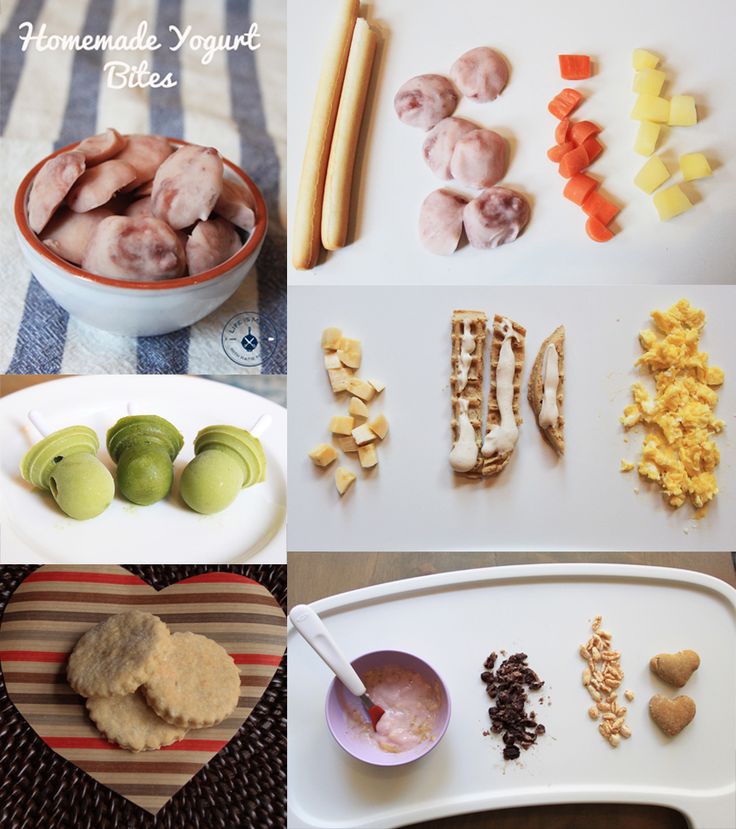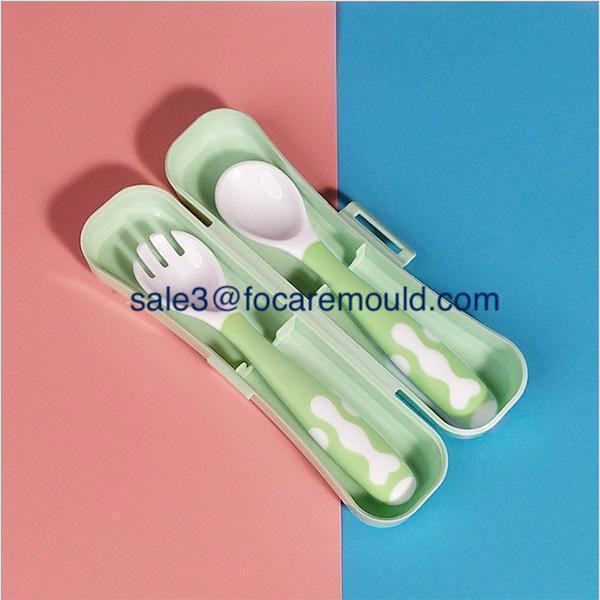Homemade baby food ideas for 7 month old
10 Easy Homemade Baby Food Ideas (No-Cook, Super Fast, Stage 1)
Learn how to make the EASIEST homemade baby food recipes (stage 1) for your little one with these super simple no-cook ideas. Plus: I have the best tips for making them ahead and freezing them so you can batch cook and simplify your days!
Homemade Baby Food
As a mom to three kids, I know firsthand how the urge to make homemade baby food can be both exciting and a little daunting. And if you have a busy schedule or other kids in the house, finding the time to actually do it can seem impossible. But, there are so many healthy foods that you can transform into stage 1 baby food purees with hardly any work or special equipment at all!
TIP: I use a regular blender for all of these recipes, so you don’t need to buy a special baby food maker unless you want to.
Baby Food Recipes for 6, 7, and 8 Month Old Babies
These homemade baby food ideas are designed for younger babies who are still eating thinner purees, but you can of course use them for older babies and toddlers too. Each can be served as is, or you can combine more than one together to create new flavors if you’re feeling creative!
TIP: If you want to add fat or protein to any of these fruit or veggie purees, simply stir in a little whole milk yogurt, coconut cream, or Avocado Puree.
Best Way to Make Baby Food
I’ve found that the easiest and most approachable way to make baby food is to simply use a blender. With fresh ingredients and a little water, breastmilk, or formula to thin it as needed, you can easily make your baby meals without investing in equipment you may not use very long.
TIP: You’ll want to start with at least 1 cup of any base ingredient to ensure that there’s enough in the blender to fully blend up.
Tools You Need to Make Homemade Baby Food
To make these baby food recipes you’ll need:
- Blender (you could also use an immersion blender if yours is very strong)
- Water, formula, or breastmilk to thin as needed
- Knife for chopping produce
- Spoon
- Bowls
- Ice cube tray
- Freezer bags for storage
- Baby food storage containers
Stage 1 Baby Food
These baby foods are meant for early eaters as they are typically very thin and easy for a baby to move around in their mouths. I follow the recommendations to wait until 6 months to start solids, so I personally don’t worry excessively about this distinction as I like babies to experience some texture in their purees. (The ones you find at the store are low allergenic foods and are meant for 4+ months.)
I follow the recommendations to wait until 6 months to start solids, so I personally don’t worry excessively about this distinction as I like babies to experience some texture in their purees. (The ones you find at the store are low allergenic foods and are meant for 4+ months.)
Stage 2 Baby Food
These baby foods are typically a little bit thicker, sometimes include more than one ingredient, and offer a wider variety of ingredients. Most babies are ready for these sorts of purees around 7-8 months, or once they’ve mastered thinner purees. (Again, since I like to do a combined baby feeding approach with both baby led weaning and purees, I don’t worry too much about following the calendar to decide when to introduce these.)
TIP: As a backup to my homemade baby foods, I love the options from Amara Organic Baby Food (paid affiliate link) since you simply need to stir it together with breast milk, formula, or water and it’s ready to serve.
And now, for my ten go-to homemade baby food purees that you don’t even need to cook!
1.
 Avocado Puree
Avocado PureeTo make avocado puree for a baby, you just need a fresh avocado, a blender, and some lemon juice if you plan to store it for later. I sometimes even do this with just a fork if the avocado is super soft! It’s a perfect way to introduce a low allergenic food that’s rich in healthy fats.
TIP: Get the full recipe for Avocado Puree here.
2. Bean Puree
Baby’s early foods don’t have to be all one food group and beans are a great food to have in the mix. You can do this easy bean puree with chickpeas, pinto beans, black beans, or even white beans, thinning it as needed with water, formula, or breastmilk. This is a great puree to mix with a little sweet potato or butternut squash.
TIP: Get the full recipe for Bean Puree here.
3. Blueberry Puree
Using fresh or frozen blueberries, this easy berry puree is loaded with fresh flavor and antioxidants. It’s delicious on its own or stirred into plain whole milk yogurt or baby oatmeal. (Note that it thickens up as it sits in the fridge, so you’ll need to stir it well to serve.)
(Note that it thickens up as it sits in the fridge, so you’ll need to stir it well to serve.)
TIP: Get the full recipe for Blueberry Puree here.
4. Kiwi Puree
With a bright flavor, this puree is great for babies who seem to love flavor—and it’s a fun one to make and store for later. You’ll want to make sure that you choose very ripe and sweet kiwi and taste it before you make the puree to ensure that it’s not too tart. (If it seems tart, you can mix with banana or applesauce.)
TIP: Get the full recipe for Kiwi Puree here.
5. Mango Puree
Using fresh or thawed frozen mango, this baby puree blends up in seconds. It’s bright, flavorful, and a great source of immune-boosting vitamins. Taste your mango to be sure that it’s sweet and not too tart. (If it’s tart, you can add Applesauce or ripe Banana Puree.)
TIP: Get the full recipe for Mango Puree here.
6. Peach Puree
Turn fresh or frozen and thawed peach slices into a super smooth Stage 1 baby food with this easy blender method. You’ll want to strain out the skin since it’s hard to blend up smooth, even with a high powered blender, but that’s so easy to do! This baby food recipe is a nice alternative to applesauce.
You’ll want to strain out the skin since it’s hard to blend up smooth, even with a high powered blender, but that’s so easy to do! This baby food recipe is a nice alternative to applesauce.
TIP: Get the full recipe for Peach Puree here.
7. Whipped Peanut Butter
This may not have occurred to you, but whipped peanut butter is a great baby food! This is a perfect way to introduce baby to peanut butter and to offer it safely there after. You just need to stir water into unsweetened creamy peanut butter until it forms a whipped consistency like yogurt. It’s smooth, not too sticky, and packed with protein.
TIP: Get the full scoop on introducing peanuts to baby here.
8. Pineapple Puree
Blend up fresh or frozen pineapple chunks into a tropical baby food puree that’s smooth and creamy. This is yummy on its own or paired with whole milk plain yogurt. Taste your pineapple to ensure that it’s not too tart. (If it’s tart, you can add Applesauce or ripe Banana Puree.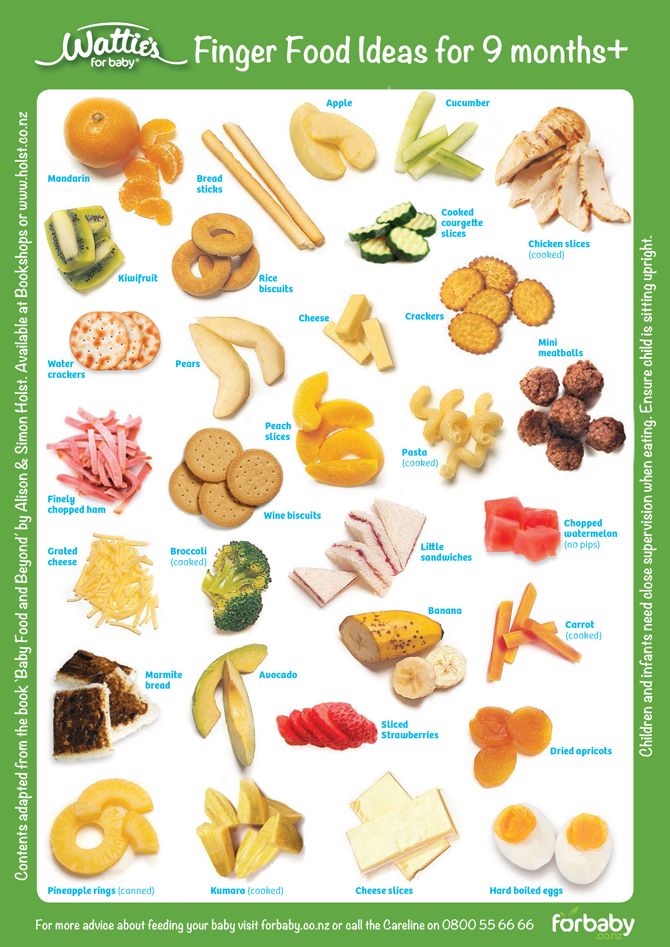 )
)
TIP: Get the full recipe for Pineapple Puree here.
9. Strawberry Puree
Fresh strawberries blend up into a perfectly smooth homemade puree without the need for any additional liquid. You can serve this as is, or mix with applesauce if desired. The flavor of your berries will determine the flavor of your puree, so be sure to taste them for sweetness.
TIP: Get the full recipe for Strawberry Puree here.
10. Banana Puree
Ripe bananas make great homemade baby food with the help of just a blender. This is a super simple baby food to make at home and it’s easy to digest as a Stage 1 baby food. Use ripe bananas with brown spots to ensure that the puree tastes sweet and is easy for baby to digest.
TIP: Get the full recipe for Banana Puree here.
Homemade Baby Food Storage
The easiest way to store homemade baby food is to add fresh purees to an ice cube tray and freeze. Once frozen, simply pop out the cubes and store in labeled freezer bags for up to 3 months. These are a perfect way to make it easy to send homemade baby food to daycare or to simply get ahead for the coming week.
Once frozen, simply pop out the cubes and store in labeled freezer bags for up to 3 months. These are a perfect way to make it easy to send homemade baby food to daycare or to simply get ahead for the coming week.
TIP: Find more information about storing baby food—including the best small food storage containers—here.
]
Tips for Making the Best Homemade Baby Food
- Use at least 1 cup base ingredient to ensure that a blender has enough volume to blend well.
- Thin any homemade puree with water, formula, or breast milk.
- Freeze any baby food you won’t use within 3 days in an ice cube tray. Transfer frozen cubes into freezer storage bags for up to 3 months. Thaw these frozen baby food recipes in an airtight container in the fridge overnight before you plan to serve.
- Taste all fresh foods for sweetness and to ensure that your puree isn’t too tart. To tame tartness, mix any puree with Banana Puree , Avocado Puree, Applesauce, or Mashed Sweet Potato.

- If you want to add fat or protein to any of these fruit or veggie purees, simply stir in a little whole milk yogurt, coconut cream, or Avocado Puree.
- Use breastmilk or formula in place of the water if desired.
- Mix two purees together for more complex flavors.
- Add texture to any puree by stirring in baby oatmeal or hemp seeds.
- For more details on each of these, find them here: Avocado Puree; Banana Puree, Bean Puree; Blueberry Puree, Kiwi Puree, Mango Puree, Pineapple Puree, Peanut Butter Puree, Peach Puree, Strawberry Puree
I’d love to hear your feedback on this way of making simple baby food, so please comment below. I so appreciate hearing your experience with my recipes!
Prep Time 5 minutes
Cook Time 0 minutes
Total Time 5 minutes
Author Amy Palanjian
Cuisine American
Course Baby Food
Calories 42kcal
Servings 4
- ▢ 1 cup blueberries, diced strawberries, diced peaches (peeled), diced kiwi (peeled), diced pineapple (peeled), diced banana (peeled), diced mango (peeled), diced avocado (peeled), OR beans (rinsed and drained)
- ▢ water, formula, or breast milk (as needed)
Choose one fruit, the avocado, or beans and add to a blender.

If making the puree with blueberries, strawberries, peaches, kiwi, pineapple, mango, or beans, add ¼ cup water and blend, adding more water as desired to make a thin, very smooth puree. If making avocado or banana, just blend (without water) until very smooth.
Serve or store in an airtight container for 3-5 days in the fridge, or up to 3 months in the freezer.
Vitamix Blender
Storage Containers
Silicone Ice Cube Tray
- Use at least 1 cup base ingredient to ensure that a blender has enough volume to blend well.
- Thin any homemade puree with water, formula, or breast milk.
- Freeze any baby food you won't use within 3 days in an ice cube tray. Transfer frozen cubes into freezer storage bags for up to 3 months. Thaw these frozen baby food recipes in an airtight container in the fridge overnight before you plan to serve.
- Taste all fresh foods for sweetness and to ensure that your puree isn't too tart.
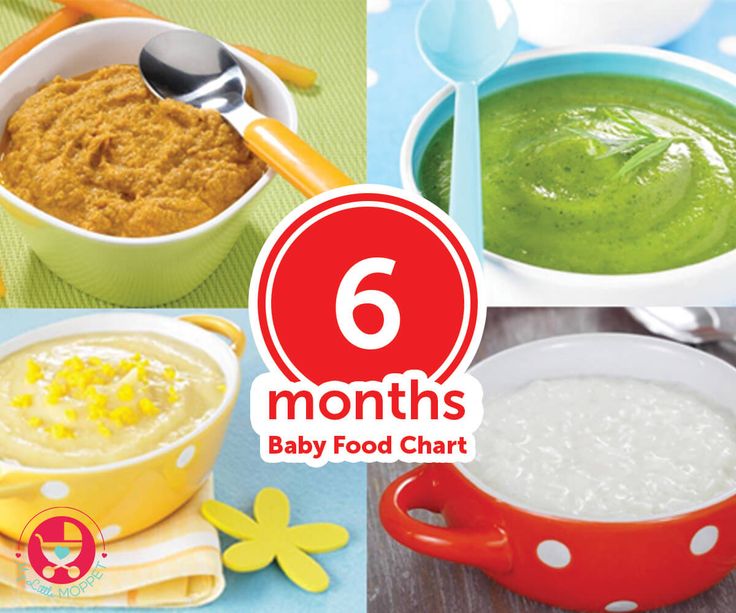 To tame tartness, mix any puree with Banana Puree , Avocado Puree, Applesauce, or Mashed Sweet Potato.
To tame tartness, mix any puree with Banana Puree , Avocado Puree, Applesauce, or Mashed Sweet Potato. - If you want to add fat or protein to any of these fruit or veggie purees, simply stir in a little whole milk yogurt, coconut cream, or Avocado Puree.
- Use breastmilk or formula in place of the water if desired.
- Mix two purees together for more complex flavors.
- Add texture to any puree by stirring in baby oatmeal or hemp seeds.
- For more details on each of these, find them here: Avocado Puree; Banana Puree, Bean Puree; Blueberry Puree, Kiwi Puree, Mango Puree, Pineapple Puree, Peanut Butter Puree, Peach Puree, Strawberry Puree
Serving: 0.25cup, Calories: 42kcal, Carbohydrates: 11g, Protein: 1g, Fat: 1g, Saturated Fat: 1g, Polyunsaturated Fat: 1g, Monounsaturated Fat: 1g, Sodium: 1mg, Potassium: 57mg, Fiber: 2g, Sugar: 7g, Vitamin A: 40IU, Vitamin C: 7mg, Calcium: 4mg, Iron: 1mg
Tried this recipe?Rate in the comments and tag @yummytoddlerfood on IG!
Tips on Freezing and Best Containers
Learn the secrets to storing and freezing homemade baby food for ultimate freshness—AND the best baby food storage containers to use to ensure that you never waste what you make!
Baby Food Storage
Going through the effort to make homemade baby food really only works if you have a good plan for how to store the food to ensure that it stays fresh and that baby has plenty of opportunities to enjoy it. After making a LOT of baby food for my third kiddo to send with him to daycare, I got into a good routine of making and storing baby food—both in the fridge and freezer. Here’s how you can do it too.
After making a LOT of baby food for my third kiddo to send with him to daycare, I got into a good routine of making and storing baby food—both in the fridge and freezer. Here’s how you can do it too.
TIP: You can find my favorite baby food recipes here.
Homemade Baby Food Storage: In the Fridge
You can store baby food in the fridge in airtight containers for up to 3 days. You can use masking tape and a Sharpie to label the containers with the contents and the date if you have a hard time keeping track of when you made something. (It’s definitely helpful to do that!)
Best Baby Food Storage Containers
I have a four favorite baby food storage containers that I use regularly.
1. Wean Green Baby Food Cubes
These are small, incredibly durable, and made from glass. They’re easy to clean and last forever. (Seriously, I’ve been using the same set for 7 years and they’re still as good as new!) $19.99 for a set of 4
2.
 Easy Lunchboxes Mini Dippers
Easy Lunchboxes Mini DippersThese small containers are a perfect size for 1-2 frozen baby food cubes and they’re my go to for packing food for a baby to take to daycare. They also nest nicely when stored in the cabinet. $7.95 for a set of 8
3. Beaba Food Storage Containers
I have two sets of these and I use them regularly for larger amounts of baby food (you could probably fit 4 cubes of frozen food) and for toddler snacks. When assembled, they snap together, so they’re an easy way to stay organized. $14.95 for a set of 6
4. Oxo Tot Baby Food Blocks
This neat system is easy to keep contained in the fridge and is also made from a polypropylene body that is PVC, BPA, and phthalate free. They are dishwasher and microwave safe. $9.99 for a set of 6
Homemade Baby Food Storage: For Freezing
Storing homemade baby food in the freezer allows you to make a bigger batch at once, and then serve it to baby over the course of a few weeks or months. The easiest way is to use an ice cube tray, which has the added benefit of portioning out the baby food nicely.
The easiest way is to use an ice cube tray, which has the added benefit of portioning out the baby food nicely.
TIP: Any ice cube tray will do. You can use silicone ice cube trays if you prefer a non-plastic option.
Baby Food Storage Without An Ice Cube Tray
If you don’t have an ice cube tray or you’d just rather not use one, you can place a predetermined amount of baby food into a pint-size freezer bag. Remove as much air as possible, press flat, and seal. Place flat in the freezer to freeze. Then you can thaw the entire bag in the fridge overnight, or break off a portion of it to thaw.
How to Store Baby Food in the Freezer Step by Step
- Place baby food into each compartment of the ice cube tray, or fill as many as you need to with the amount of baby food you have.
- Cover (if your ice cube tray has a cover) and freezer for 4-6 hours or overnight.
- Pop out frozen cubes and transfer to freezer storage bags. Label as desired with the type of baby food and the date.

- Store in the freezer for up to 3 months.
TIP: I like to have a bag of sweet fruit purees and more savory vegetable purees to avoid having too many separate bags in the freezer at any given time. Then you can combine them into baby food combinations easily!
How to Thaw Baby Food
To thaw baby food, simply remove a cube (or as many as you need) and place into airtight containers. Thaw overnight in the fridge and serve. 1 cube may be plenty for a baby aged 6-7 months and older babies may enjoy two cubes.
Tips for the Best Baby Food Storage
- Keep fresh baby food in an airtight container for up to 3 days in the fridge.
- Use a regular ice cube tray to freeze, a silicone ice cube tray with a lid, or a small freezer bag with the contents pressed flat.
- Store frozen baby food in a freezer storage bag in the freezer for up to 3 months.
- To avoid freezer burn, try to remove as much air as possible from the storage bags.

- Label your bags with the contents and the date.
- To thaw baby food, simply remove a cube (or as many as you need) and place into airtight containers. Thaw overnight in the fridge.
- Use leftover baby food to flavor yogurt, baby oatmeal, baby rice cereal, smoothies, or cottage cheese.
- See some of my favorite Baby Food Pouch recipes here for more ideas on how to serve your baby food!
I’d love to hear your feedback if you have another storage technique or container that you love, so please comment below!
7-month-old baby's menu for every day of the week with recipes - Topotushki
Every day, growing babies become more active and expend more energy, which needs to be replenished with additional nutrients. Therefore, gradually “adult” products should be introduced into the child’s diet, since the usual diet is no longer enough for the child’s body. Seven-month-old fidgets by this age sit and crawl, and some even try to stand on their feet and take their first steps. Of course, formula (or breast milk) is still the main food, but the constant activity of the baby requires a more complete diet. What can a seven-month-old toddler eat and drink? Let's consider this question in detail. nine0003
Of course, formula (or breast milk) is still the main food, but the constant activity of the baby requires a more complete diet. What can a seven-month-old toddler eat and drink? Let's consider this question in detail. nine0003
Contents
- Baby nutrition - what new foods should be introduced into the diet
- Are there differences in the nutrition of infants and artificial babies?
- Daily diet for breastfeeding and artificial feeding
- Sample menu for a 7-month-old baby for each day of the week
- How to properly feed your baby with new foods and dishes
- Opinion of Dr. Komarovsky
- Recipes for the most delicious and healthy meals
- buckwheat porridge with a banana
- rice porridge with an apple
- oatmeal with pumpkin
- vegetable cabbage puree
- Curin puree-puree
- compot of apple-bristle dried fruits
Power supply-what new products should be introduced-what new products should be introduced.
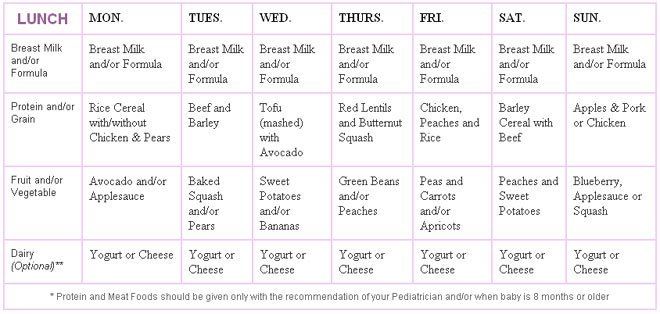 in the diet
in the diet - Porridge. This dish must be present in the menu of a seven-month-old baby, but cereals must be chosen without gluten (buckwheat, rice and corn). In addition, these cereals have significant benefits. Buckwheat is rich in iron and is perfectly absorbed by the body. Rice groats are nutritious and useful for loose stools. Corn grits stabilizes the work of the intestines and is indispensable for toddlers prone to allergic reactions. You can also give your kids oatmeal. nine0008
- Meat. At the age of seven months, you need to start introducing meat into your baby's diet, which is rich in protein, vitamin B, phosphorus, potassium and magnesium. This product is especially useful for children with anemia and for those who are not gaining weight well. But for starters, it is recommended to give only dietary meats: turkey, chicken and rabbit meat. It is best to cook these dishes in the form of mashed potatoes or soufflés, diluted with breast (not cow!) Milk or water.
 It is undesirable to add broth after cooking meat. nine0008
It is undesirable to add broth after cooking meat. nine0008 - Yolk. Due to the fact that egg yolk can cause an allergic reaction, it should be introduced into the baby's diet very carefully, starting with a small piece. You need to dilute this product with breast milk or a mixture, gradually bringing its amount to half the yolk. It contains a lot of fats, vitamins, iron and phosphorus necessary for the body. It is not necessary to give the child boiled yolk in its pure form, it can be added to meat and vegetable purees, but not every day, but two or three times a week. nine0008
- Vegetables. Pureed vegetables are an indispensable dish for children of the age of seven months. It is good for the stomach and intestines, as it is rich in fiber and minerals. You should start with zucchini and cabbage (any), and then gradually introduce pumpkin, carrots and potatoes into the diet of crumbs. You can also enrich vegetable puree with beans or green peas.
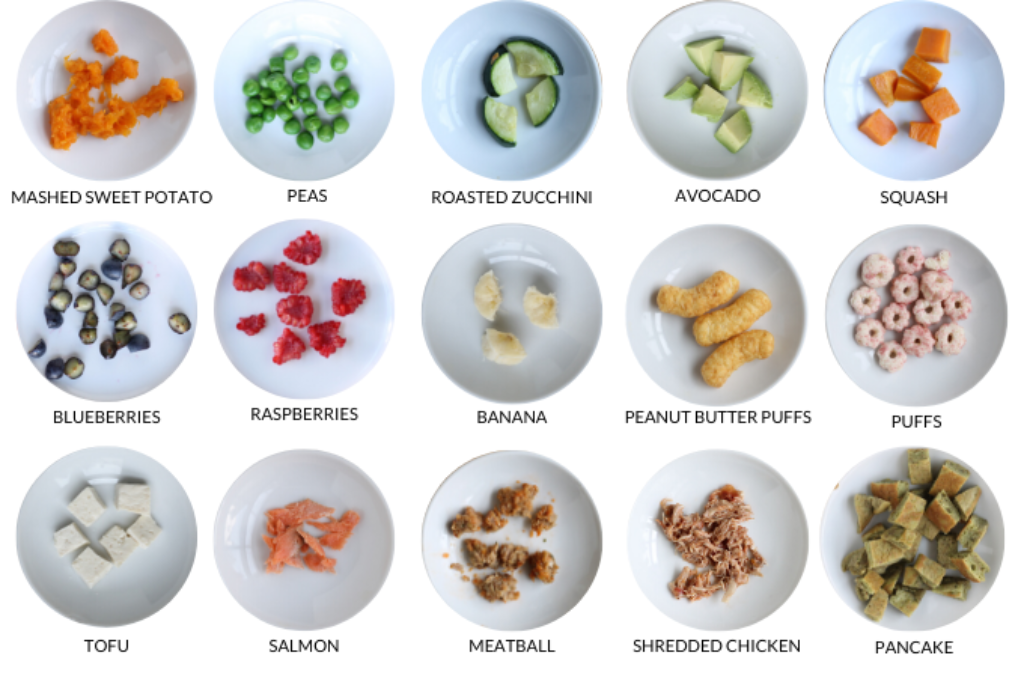 But just add a little, it’s too early to give these products to a seven-month-old peanut as an independent dish. nine0008
But just add a little, it’s too early to give these products to a seven-month-old peanut as an independent dish. nine0008 - Fruit. Absolutely all children love fruit puree, especially if it is bananas and apples. Also, many kids love pear and apricot puree. Such a dish as complementary foods must be present, because there are a lot of vitamins in fruits. Moreover, you only need to mash the banana with a fork, and rub the apple on a grater - and a delicious delicacy is ready.
- Drinks. In addition to boiled water, which the child must be given every day, you can also cook compote and make freshly squeezed juice. First from apples, and later add pears, plums, apricots. In winter, dried fruits can replace fresh fruits. It is better not to add sugar, if only very little, when the compote really needs to be sweetened. You can also make drinks from some vegetables, for example, from carrots. It turns out very tasty and healthy juice, which children drink with pleasure.
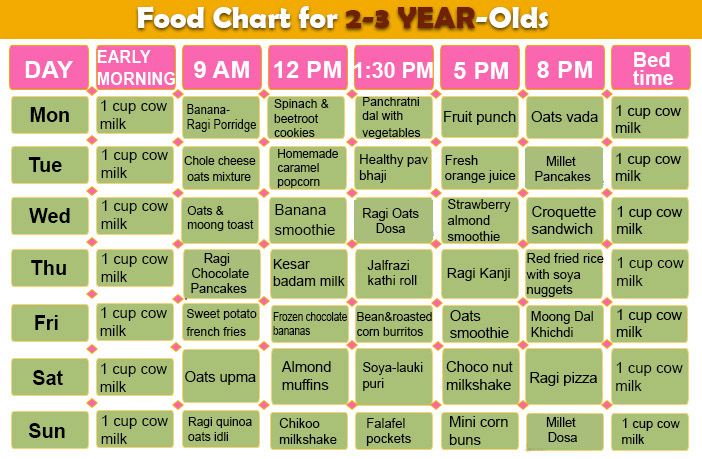 nine0008
nine0008 - Kefir, cottage cheese. For good nutrition, pediatricians recommend adding fermented milk products (cottage cheese and kefir) to the diet of seven-month-old children, without which it is already undesirable to do. They contain proteins, phosphorus, potassium and calcium, in addition, they are useful for digestion. It is better to give cottage cheese homemade - his children eat more willingly. Kefir "for adults" should be left for yourself, and the kids should be offered a special children's one. Moreover, the first portion should not exceed twenty grams, otherwise a load on the stomach will be created. The amount of cottage cheese and kefir should be increased gradually. nine0008
How much complementary foods a child should eat - complementary foods table
The main food of an infant at this age is still milk (mother's or adapted formula). But even with full breastfeeding, the baby must eat additional foods so that his body receives the necessary and important vitamins and minerals for health. Specialists in the field of pediatrics have developed a complementary feeding table, which describes in detail how to feed a child at this age. nine0003
Specialists in the field of pediatrics have developed a complementary feeding table, which describes in detail how to feed a child at this age. nine0003
| Food and dish names | Daily allowance | Important rules |
|---|---|---|
| Cereals (oat, corn, buckwheat, barley, rice) | 150 g | Do not dilute with cow's milk. |
| Vegetable puree (pumpkin, cabbage, carrot, marrow) | 170 g | Green peas can be added. |
| Fruit puree (banana, apple, pear, plum) | 70 g | Without citrus fruits! |
| Meat puree (chicken, turkey, rabbit) | 30 g | Do not give meat broth. |
| Dairy products (cottage cheese, kefir) | 50-150 g | Kefir should be for children. |
| Boiled chicken yolk | 0.25 g | Only yolk, no protein! |
| Juices and compotes (carrot, apple, apricot, peach) | 70 ml | Dilute half and half with water. |
| Biscuits, croutons, crackers | 3 pcs | Soak in water or milk. |
Are there differences in the nutrition of infants and artificial babies?
Most mothers believe that if their babies eat a lot of breast milk by the age of seven months, then they do not need additional food, so they are in no hurry to introduce complementary foods. However, many experts are of the opinion that even if the child continues to eat breast milk with pleasure, his body is already beginning to feel the need for vitamins and minerals that can be obtained from healthy foods. Therefore, the baby needs to introduce complementary foods, but the portions should be very small, literally half a dessert spoon, because this is new food for the baby. nine0003
If the child is bottle-fed, then one adapted formula is not enough for him by the age of four or five months. And by the age of seven months, a portion of "artificial" should not only be slightly different from the diet of children who feed on mother's milk, but also be larger in grams.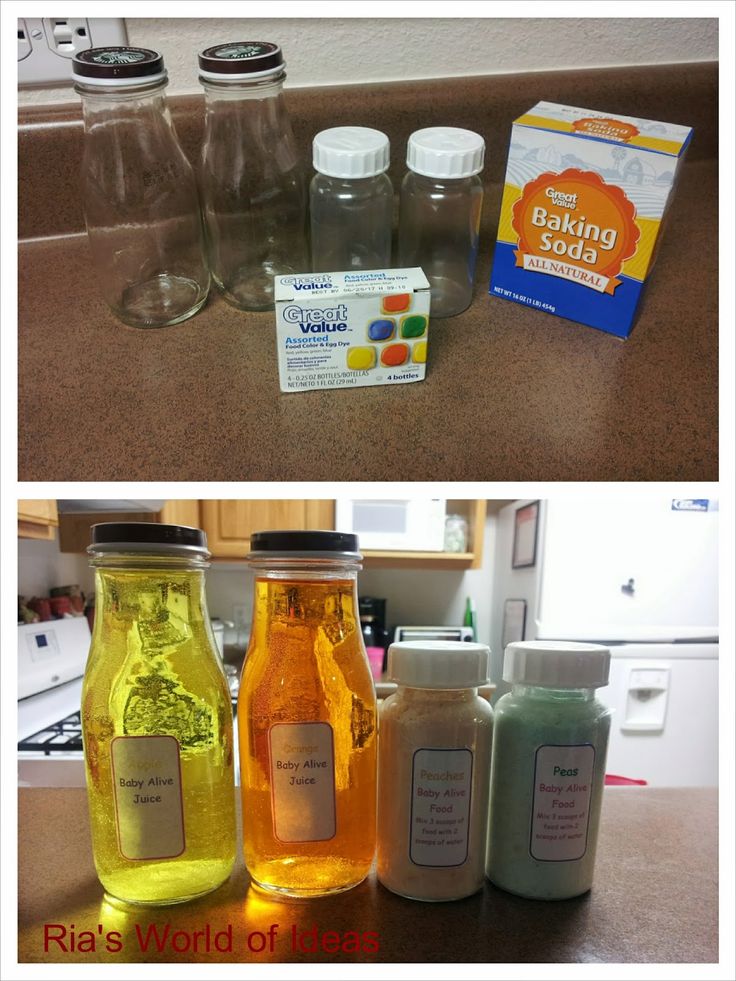 Here it is better to focus on the feeding table and calculate the amount of food in relation to the weight of the baby. This is necessary so that the volume of each serving does not exceed the indicators indicated in the table - it will be much easier for mothers with it. nine0003
Here it is better to focus on the feeding table and calculate the amount of food in relation to the weight of the baby. This is necessary so that the volume of each serving does not exceed the indicators indicated in the table - it will be much easier for mothers with it. nine0003
Daily diet for breastfeeding and formula feeding
The menu for a 7 month old breastfed baby is slightly different from the menu for a baby fed with an adapted formula. The products are given almost the same, the difference is only in the dosage. A baby who has already switched completely to an adapted formula needs a little more food than a breastfed baby.
| Feeding time | Breastfeeding | Formula-fed |
|---|---|---|
| 6.00-7.00 | Mother's milk. | Milk formula. |
| 10.00-11.00 | Porridge (150 gr.), fruit puree (50 gr.). | Porridge (180 gr.), fruit puree (80 gr. ). ). |
| 14.00-15.00 | Vegetable puree (150 gr.), meat puree (150 gr.), juice or compote (50 ml). nine0087 | Vegetable puree (180 gr.), meat puree (180 gr.), juice or compote (80 ml). |
| 18.00-19.00 | Cottage cheese (40 gr.), kefir (100 ml), biscuits. | Cottage cheese (50 gr.), kefir (150 ml), half an egg yolk. |
| 22.00-23.00 | Mother's milk. | Milk formula. |
As can be seen from the table, the diet of infants does not depend on the type of feeding and includes five meals a day with an interval of no more than 4 hours. nine0003
Approximate menu for a 7-month-old baby for each day of the week
The diet of toddlers should be varied and age appropriate. We offer to help mothers an approximate daily menu, in which the first breakfast and the last feeding must necessarily include breast milk or milk formula. What the child can eat and drink at other meals is suggested in the table.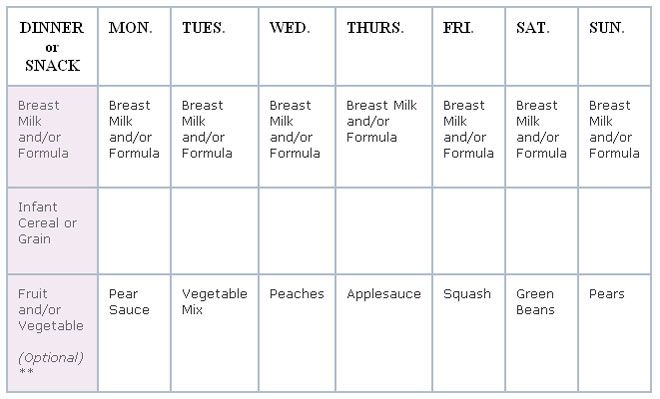
| Day of the week | Food intake | What can you offer your baby |
|---|---|---|
| Monday | Breakfast №2 | Semolina porridge with dried fruits (150 g), cottage cheese with peach pulp (50 g), pear puree (50 g). |
| Lunch | Cabbage-pumpkin puree (180 g), turkey meat mousse (70 g), 1/2 egg yolk, compote (150 ml), bread. | |
| Snack | Homemade yogurt (100 g), buckwheat porridge (50 g), green apple puree (50 g), baby biscuits (5 g). | |
| Tuesday | Breakfast №2 | Buckwheat porridge with pumpkin (100 g), plum puree (50 g), children's cottage cheese (50 g). |
| Lunch | Potato soup with meatballs with onions, cabbage, carrots, herbs (200 g), pear and peach puree (50 g), bread. | |
| Snack | Baby yogurt (100 ml), oatmeal (100 g), green apple baked in the oven.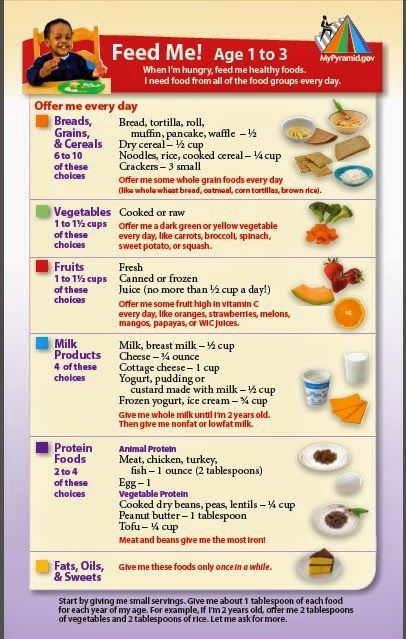 | |
| Wednesday | Breakfast №2 | Rice pudding (100 g), kissel (50 g), curd soufflé (50 g). nine0087 |
| Lunch | Pumpkin soup (200 g), fish cakes (50 g), fruit juice (50 g), bread (5 g). | |
| Afternoon snack | Homemade yogurt (100 ml), corn porridge with pear and apple (100 g) cracker. | |
| Thursday | Breakfast №2 | Oatmeal with berries (100 g), baby cottage cheese (50 g), chopped prunes. |
| Lunch | Broccoli and rabbit vegetable puree (200g), peach puree (50g), fruit juice (80g), bread (5g). nine0087 | |
| Afternoon snack | Kefir for children, rice porridge (100 g), children's cookies (5 g). | |
| Friday | Breakfast №2 | Corn porridge with pear (100 g), baby cottage cheese (50 g), pear puree (50 g). |
| Lunch | Chicken soup (200 g), pear puree (50 g), berry juice (70 g), bread (5 g).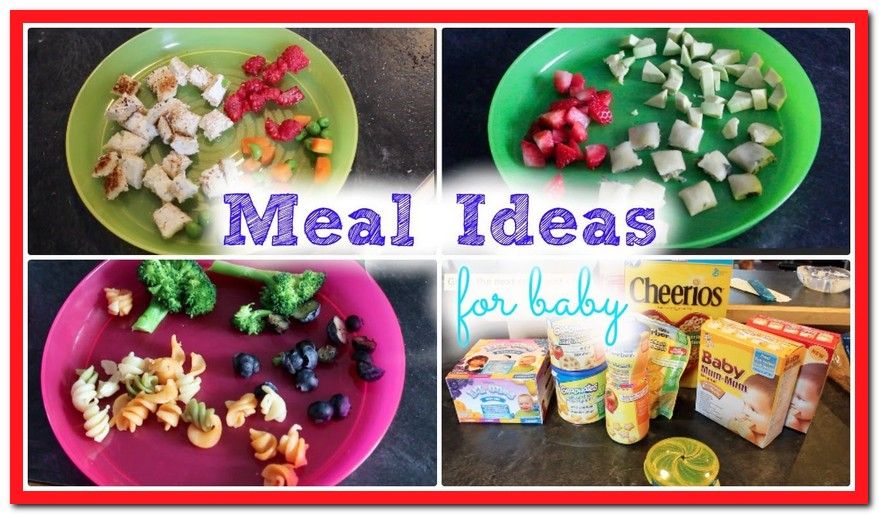 | |
| Snack | Homemade yogurt (150 g), baby biscuits (5 g), barley porridge (100 g). nine0087 | |
| Saturday | Breakfast №2 | Buckwheat porridge with peach (100 g), cottage cheese for children (50 g) fruit juice. |
| Lunch | Mashed marrow, carrot, turkey meat (200 g), baked apple with berries, bread (5 g). | |
| Snack | Kefir (150 ml), cracker, oatmeal porridge (100 g), applesauce (50 g). | |
| Sunday | Breakfast №2 | Barley porridge with pumpkin (100 g), cottage cheese with plums (50 g), fruit jelly. nine0087 |
| Lunch | Vegetable soup with beets (180 g), fish puree (50 g), peach and pear fruit puree (50 g), compote (100 g). | |
| Snack | Yogurt with pear puree (150 g), baby biscuits, buckwheat porridge (100 g). |
Video about the baby's menu at 7 months
How to properly feed the baby with new foods and dishes
Every mother wants her baby to accept new foods well and eat with appetite. However, this can be achieved only if simple rules are observed, otherwise the child may refuse unfamiliar food. Most children accept new foods well, but it happens that for unknown reasons they do not want to eat cereals and mashed potatoes. The reasons may be different, so it is recommended to follow the following rules. nine0003
- Do not force feed a child if he refuses to eat – do not force him to swallow “at least a spoonful”. Try later - perhaps you have not cooled the dish enough and it is hot for the baby, or he is just not hungry yet.
- In a new dish there should be only one product unfamiliar to the little one.
 It is necessary to introduce the child to complementary foods gradually, and each new ingredient should be introduced little by little and in small doses.
It is necessary to introduce the child to complementary foods gradually, and each new ingredient should be introduced little by little and in small doses. - It is undesirable to give the baby to drink water during feeding - only between them. This applies to boiled water, not juices and compotes (they should be offered to the crumbs after each meal). Liquid is best given in a non-spill bottle. nine0008
- All dishes must be of uniform consistency, without pieces or lumps. To do this, it is not enough just to knead the products with a fork, it is better to chop in a blender. Or grate, then rub through a sieve.
- It is very important how and what your fidget eats. He should eat only while sitting (for example, on a special highchair), but in no case lying down. It is recommended to use a plastic spoon as a cutlery.
- The first acquaintance with a new dish is best done in the afternoon during lunch, by this time the baby's body is already ready to accept unfamiliar food, and the mother will have the opportunity to observe how the body has absorbed the new product until the evening.
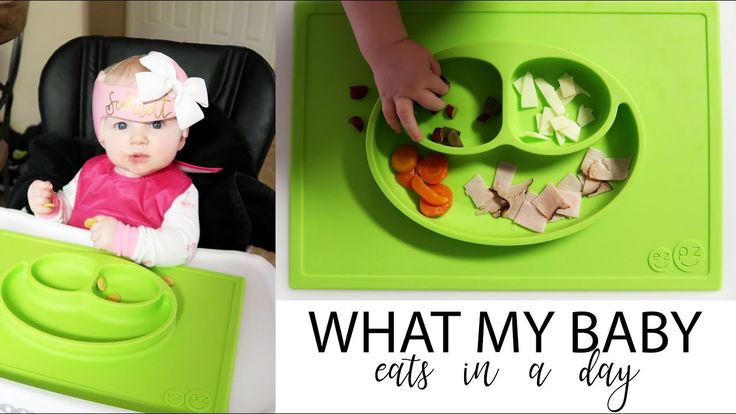 nine0008
nine0008
Doctor Komarovsky's opinion
Many mothers listen to Dr. Komarovsky, a specialist in pediatrics, and trust his opinion. What does he think about complementary foods at seven months of age? On this score, Evgeny Olegovich is categorical: it is necessary to introduce crumbs of porridge into the diet, especially buckwheat and rice. And it is better to give them during dinner, before going to bed. But with semolina, you should wait, her turn will come later. And if meat and vegetables can be introduced into the baby's menu even in the eighth month, then cereals will certainly be in the seventh - at this age they are very important for the child's body, says Dr. Komarovsky. nine0003
Read also articles on nutrition and development:
- Choosing hypoallergenic porridge for complementary foods
- Assortment of dairy-free cereals for the first feeding
- Child development by months up to a year
- Wisdom of the first porridge
- When can milk porridge be given to a child
- Daily routine of a child at 7 months
Recipes for the most delicious and healthy dishes
The recipes offered are simple and quick to prepare.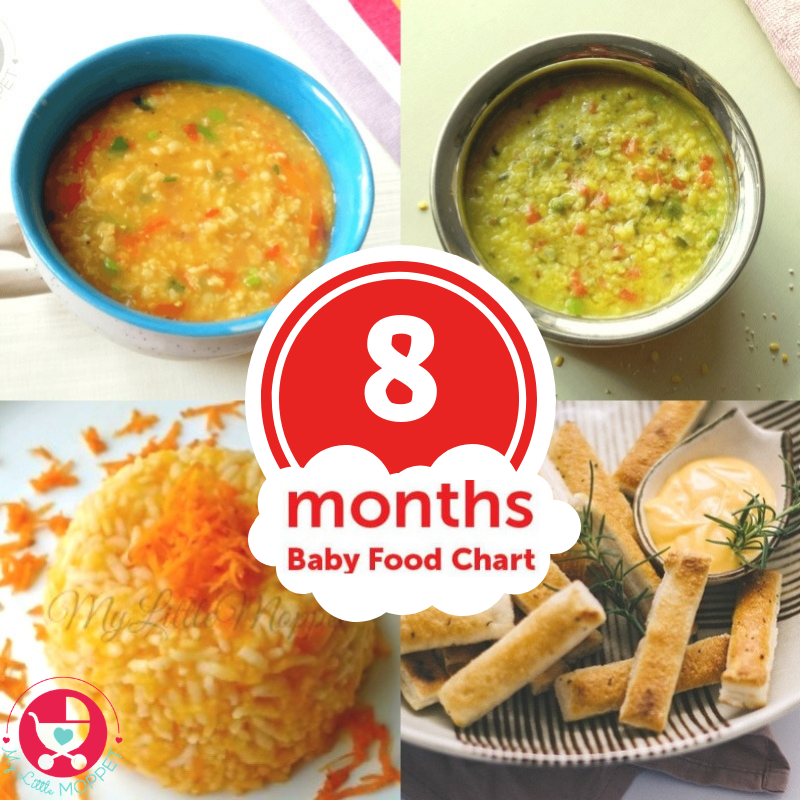 They will allow you to diversify the baby's menu and give him the pleasure of a new taste. nine0003
They will allow you to diversify the baby's menu and give him the pleasure of a new taste. nine0003
Buckwheat porridge with banana
20 gr. grind buckwheat into flour and cook in 200 ml. water. Crumble a banana (30 gr.) into the finished mass and chop in a blender. You can add a small piece of butter or a drop of vegetable oil to the porridge.
Rice porridge with apple
20 gr. grind rice groats into flour and cook in 200 ml. water. Peel the apple, grate, add to the porridge and grind in a blender. Be sure to put a piece of butter on the tip of a knife in the finished dish. nine0003
Oatmeal with pumpkin
50 gr. stew peeled and diced pumpkin in 200 ml. water for 20 minutes, then add 20 gr. oatmeal. Then simmer for another 20 minutes over very low heat. Then grind the finished porridge to a homogeneous mass.
Vegetable cabbage-carrot puree
A very easy-to-prepare dish that resembles cream soup in texture. 50 gr. cauliflower and 50 gr.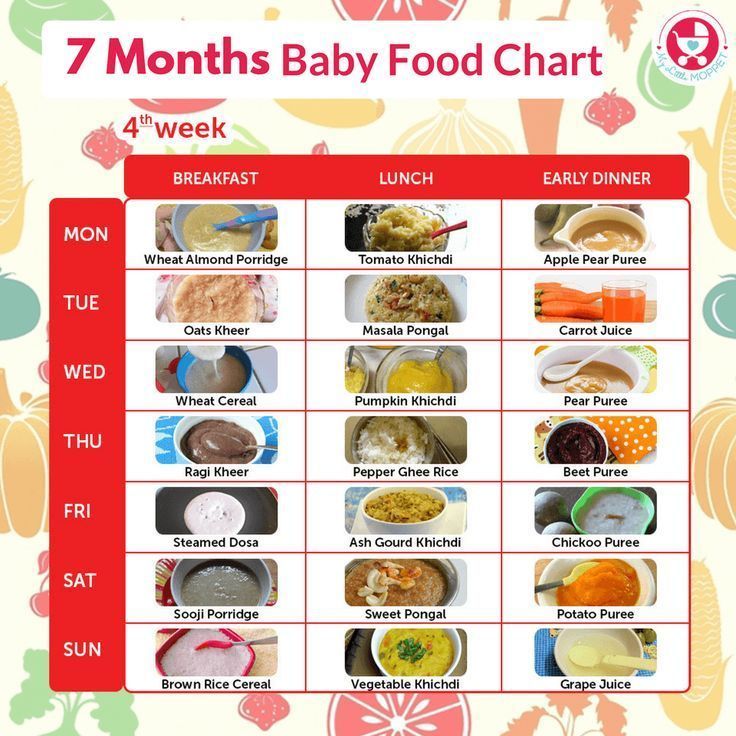 boil the carrots and use a blender to grind into a puree. Dilute with the broth in which the vegetables were cooked. nine0003
boil the carrots and use a blender to grind into a puree. Dilute with the broth in which the vegetables were cooked. nine0003
Chicken meat puree-soufflé
Boil 50 g of chicken breast until tender and mince (twice). In the resulting mass, put half the yolk and a piece of butter, dilute with chicken broth and cook for 20 minutes in a steam bath.
Dried apple and pear compote
25 gr. dried apples and 25 gr. pour dried pears overnight with warm boiled water, drain it in the morning. Pour 500 ml. fresh water and bring to a boil over low heat. Remove from heat and leave for an hour under a closed lid. nine0003
Nekrasova Anastasia Mikhailovna
Pediatrician, pediatric cardiologist
Ask a question
Irina.
Good afternoon, Anastasia Mikhailovna!
The child has recently turned 7 months old. What to feed at 18.00, if cottage cheese has just begun to be introduced? Porridge, fr puree and mix?
Hello, you can feed porridge (different, not the one in the morning), fruit puree, biscuits.
Diet of a 7-month-old baby: menu for a small child
The baby is 7 months old, already sitting and leading a fairly active lifestyle . What should be the menu of a 7 month old baby ? What a baby needs at this age, and what dishes can diversify his diet so that the baby’s body receives useful vitamins and minerals, we will tell in our article.
In the menu of a 7 month old baby, it is already possible to introduce new products , especially if the process of feeding has begun and vegetables , fruits and cereals the baby has already tried. What new tastes can be offered to the baby? nine0003
Meat
7 months — time to introduce into the child's diet meat , it contains a lot of necessary protein, which will serve as a building material for a growing organism, vitamins A, B, B12.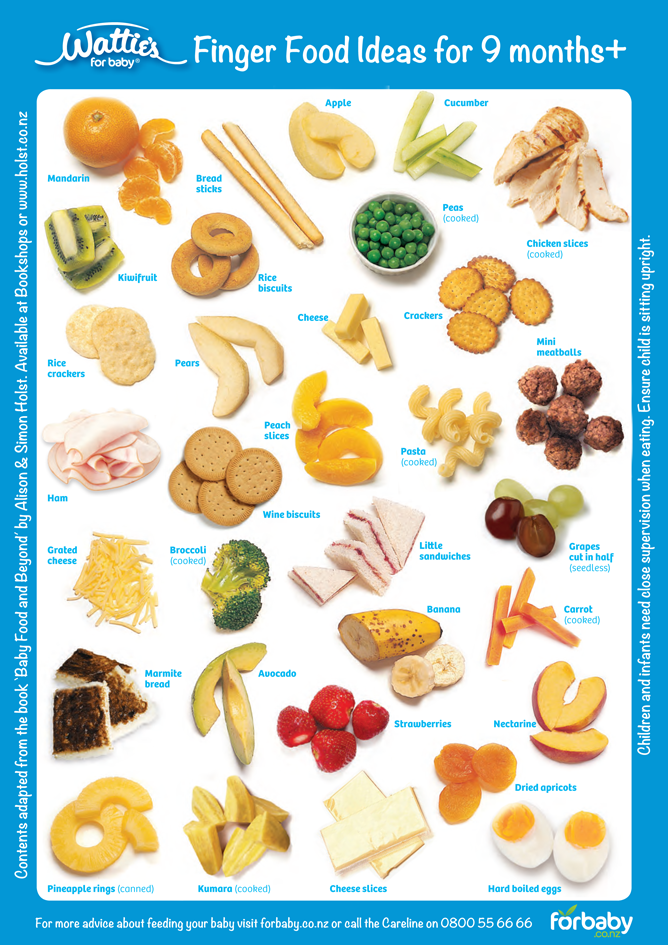 You can offer your baby lean beef, veal, rabbit, turkey or chicken.
You can offer your baby lean beef, veal, rabbit, turkey or chicken.
Meat must be boiled, chopped in a blender, and adding a little broth so that it does not dry out, and serve the baby separately or, for example, mix with vegetable puree, add to soup or boil it in meat broth. nine0003
If meat from special canned food for children is introduced into the child's diet, then it is better to start with homogenized options, containing only meat , and one type, without additional components.
In children prone to food allergies, selection of meat is carried out taking into account individual tolerance . When buying, be sure to pay attention to the composition of canned food and the age from which this product can be used. Usually all the necessary data are indicated on the packaging. nine0003
Remember to follow the rules for introducing a new product in the child’s menu: first, give the baby a little bit of meat and look at the reaction of his body, if everything is in order during the day, the next day the baby can be given a little more, and gradually, day by day, bring the amount of the new product to the required level.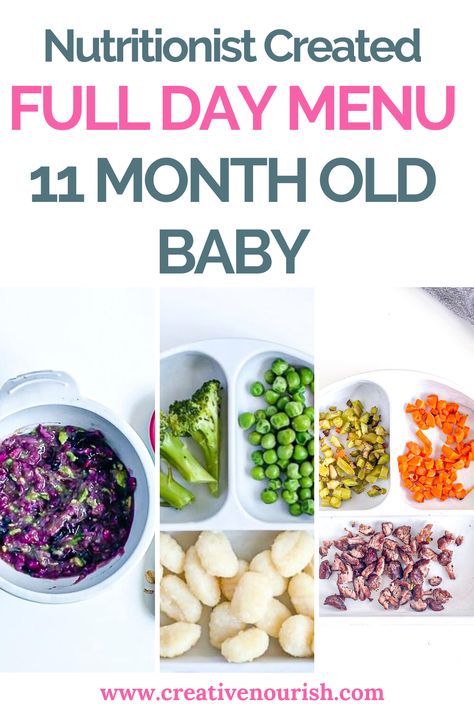
Read also0483 : "I give meat for lunch, and since my son somehow doesn't like it very much - I mix it in soup, or in vegetable puree. I tried to add breast milk to meat, a little buckwheat porridge - does not want But he eats with vegetables, thanks for that too.”
Yolk
Another new product is Yolk , the most valuable part of the chicken egg. The yolk contains unsaturated fatty acids, fat-soluble vitamins A, E and D and carotene, as well as phosphorus and iron. nine0003
Parents should take into account that we are talking about the yolk and not about the whole egg, as the protein is quite an allergenic product. However, giving the baby a yolk, you also need to make sure that the crumbs do not have any negative reactions to it. Like any new product on the child's menu, pediatricians recommend introducing the yolk carefully, not mixing with other new products. There is an opinion that quail eggs are an excellent way out for allergic kids, but allergies can also occur on protein and quail eggs. nine0003
There is an opinion that quail eggs are an excellent way out for allergic kids, but allergies can also occur on protein and quail eggs. nine0003
Doctor E.O.Komarovsky's opinion on this matter is as follows : "There is no fundamental difference between a chicken egg and a quail egg. Whatever bird eggs you choose, they should be given to the child in a thermally processed state. Give the child raw eggs fundamentally wrong. For absolutely all birds can be carriers of such a dangerous disease as salmonellosis. Sometimes, when a child loves eggs very much, it is difficult for parents to give him half a chicken egg, but a quail egg is just right. " nine0003
When compiling a menu for a 7-month-old baby, it is worth distributing dishes in such a way that the second feeding acts as breakfast, and the meal around 14.00 is lunch. Parents should gradually form in the child the traditional adult division of food during the day for breakfast, lunch, afternoon tea and dinner. After all, soon the number of meals for the crumbs will be reduced, and the healthy habit of eating porridge for breakfast, soup for lunch, and cottage cheese for an afternoon snack will remain, and such a diet will seriously make life easier for parents. nine0003
After all, soon the number of meals for the crumbs will be reduced, and the healthy habit of eating porridge for breakfast, soup for lunch, and cottage cheese for an afternoon snack will remain, and such a diet will seriously make life easier for parents. nine0003
However, if a child eats vegetable puree better in the morning or in the evening, and likes porridge during the day, there is nothing to worry about, feel free to focus on his preferences and tastes.
What, when and why? The first and last feeding is either breastfeeding or, if the baby is formula-fed, an adapted mixture.
Our mother, a member of the House forum, tells : "We have the following menu: 7-00 breast, at 10-00 porridge (any), at 13-00 meat puree with vegetables (half of the yolk 2-3 times a week), at 16 -00 cottage cheese, fruit puree, breasts at 19:00, breasts at 21:30 at night, and wakes up every 2 hours all night to eat. plain drinking water".
If we take into account that vegetable purees, juices, cereals, meat, yolk and dairy products have already been introduced into the baby’s complementary foods, then The estimated menu of the 7 -month -old child may look as follows :
after waking up - breast milk or adapted mixture
Breakfast - about 10.00 9000
Lunch - approx. nine0008
Afternoon snack - about 18.00
- porridge with milk or dairy-free - 50 g;
- cottage cheese - 30 g.
- juice or fruit puree - 30 ml.
- cookies - 1-2 pcs. (optional)
Dinner - breast milk or adapted formula
If your baby is not eating well or is not eating well, offer breast milk or formula after every meal .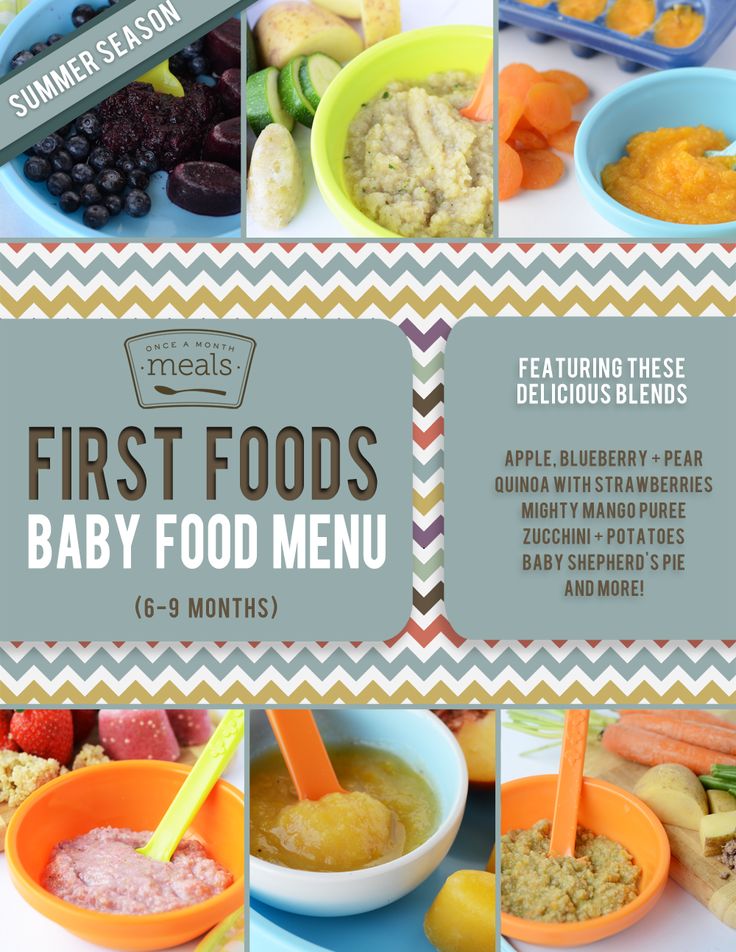
If both meat and yolk are included in the baby's menu, then first new products should be divided into meals, and given, for example, yolk for breakfast or afternoon tea, and meat for lunch.
What if he doesn't want to?
We are sure that parents should not be nervous if the kid flatly refuses to try one of the dishes we offer - all children are individual , each has its own taste and different rates of introduction of new dishes.
Our forum member mother Vikusia tells : “Lina wanted to try her first complementary foods at 10 months old. At first I was nervous, and my grandmothers insisted, how is it that, they say, nothing from mother’s milk gets to the child, she doesn’t get enough, she will get rickets, she needs to be fed “like a human being.” But when we weighed ourselves at the pediatrician’s reception at 6, 7, 8 months, and the small one adds only 800 g per month on my milk alone, the doctor said - nothing to worry about.